Abstract
OBJECTIVES. The largest known dioxin contamination occurred between 1962 and 1970, when 12 million gallons of Agent Orange, a defoliant mixture contaminated with a form of the most toxic dioxin, were sprayed over southern and central Vietnam. Studies were performed to determine if elevated dioxin levels persist in Vietnamese living in the south of Vietnam. METHODS. With gas chromatography and mass spectroscopy, human milk, adipose tissue, and blood from Vietnamese living in sprayed and unsprayed areas were analyzed, some individually and some pooled, for dioxins and the closely related dibenzofurans. RESULTS. One hundred sixty dioxin analyses of tissue from 3243 persons were performed. Elevated 2,3,7,8-tetrachlorodibenzo-p-dioxin (TCDD) levels as high as 1832 ppt were found in milk lipid collected from southern Vietnam in 1970, and levels up to 103 ppt were found in adipose tissue in the 1980s. Pooled blood collected from southern Vietnam in 1991/92 also showed elevated TCDD up to 33 ppt, whereas tissue from northern Vietnam (where Agent Orange was not used) revealed TCDD levels at or below 2.9 ppt. CONCLUSIONS. Although most Agent Orange studies have focused on American veterans, many Vietnamese had greater exposure. Because health consequences of dioxin contamination are more likely to be found in Vietnamese living in Vietnam than in any other populations, Vietnam provides a unique setting for dioxin studies.
Full text
PDF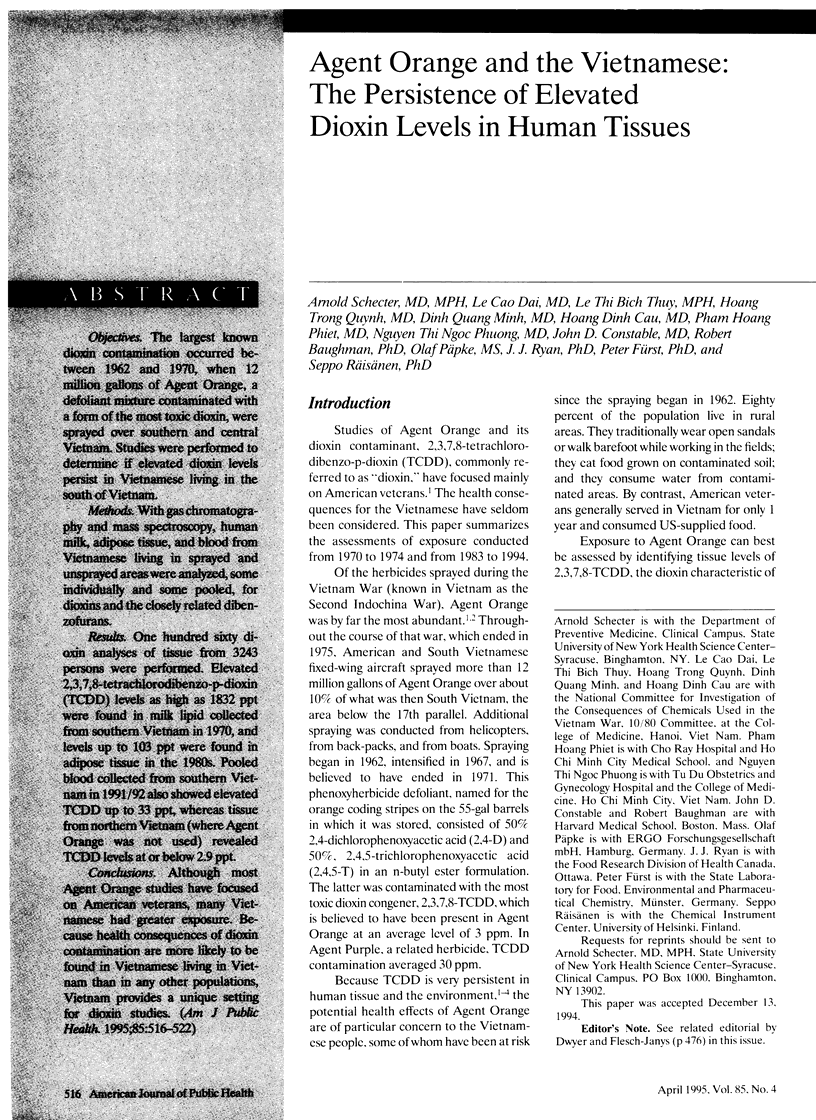
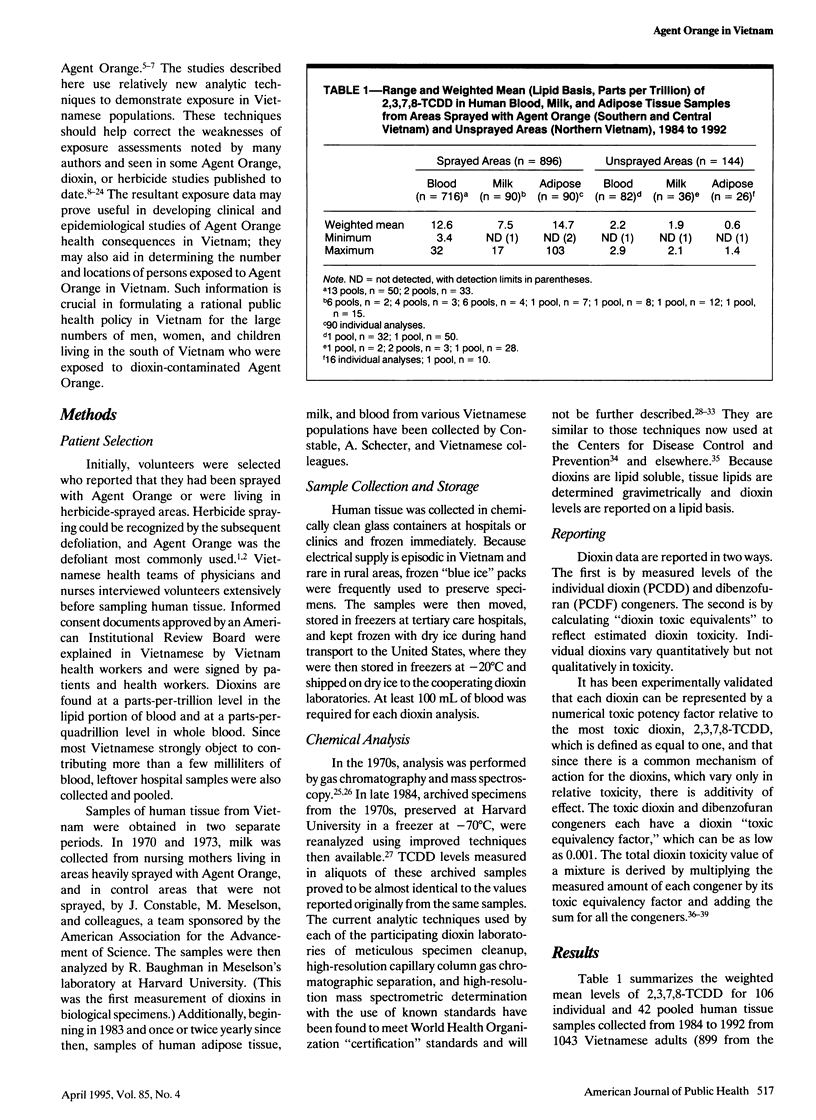
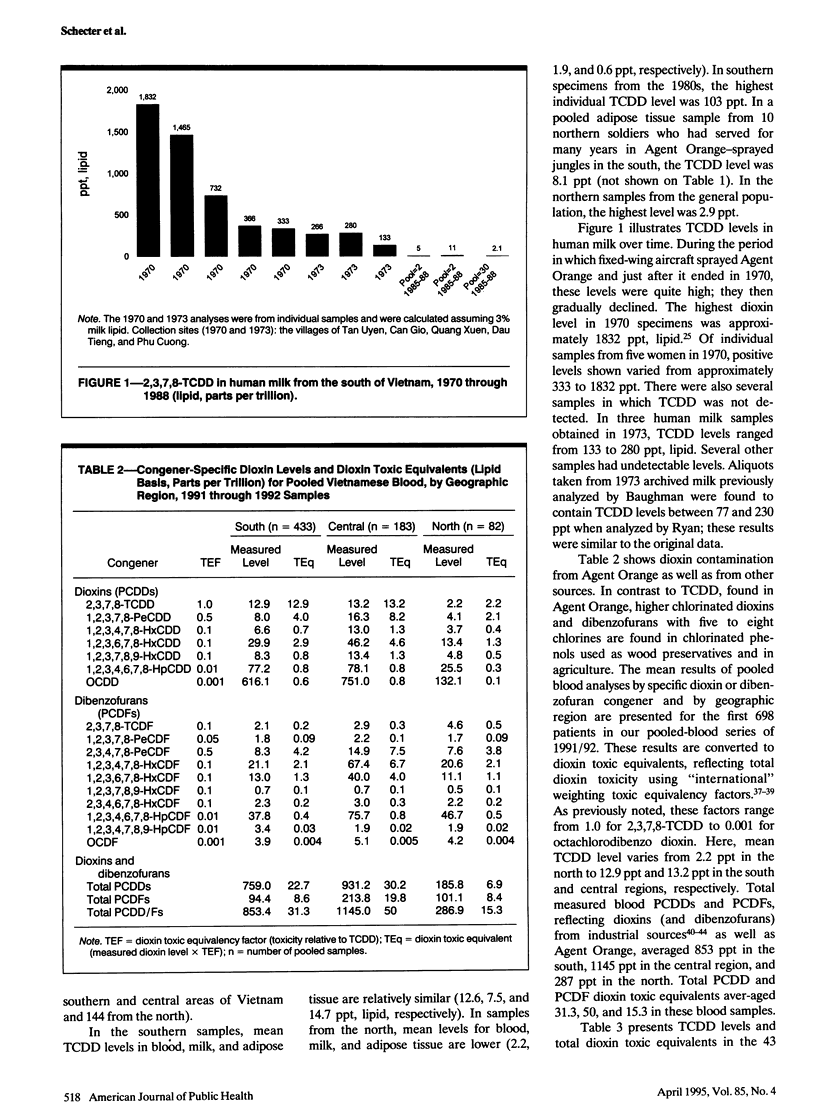
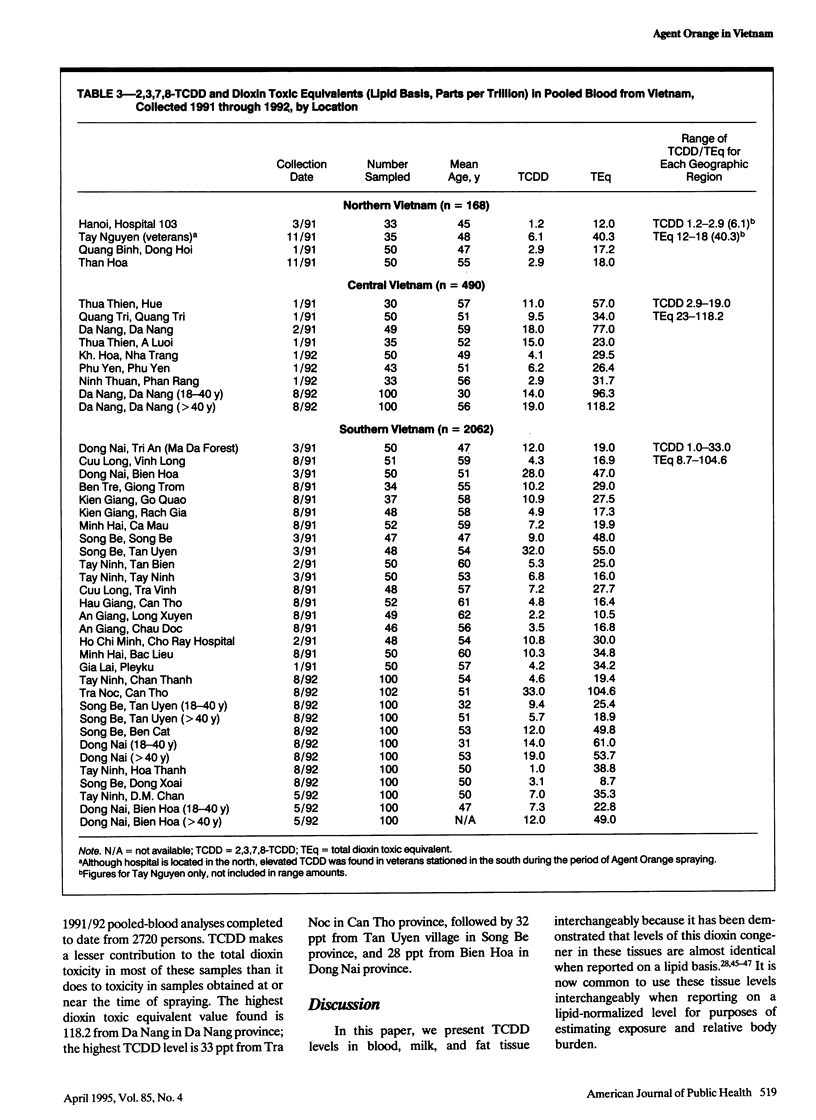
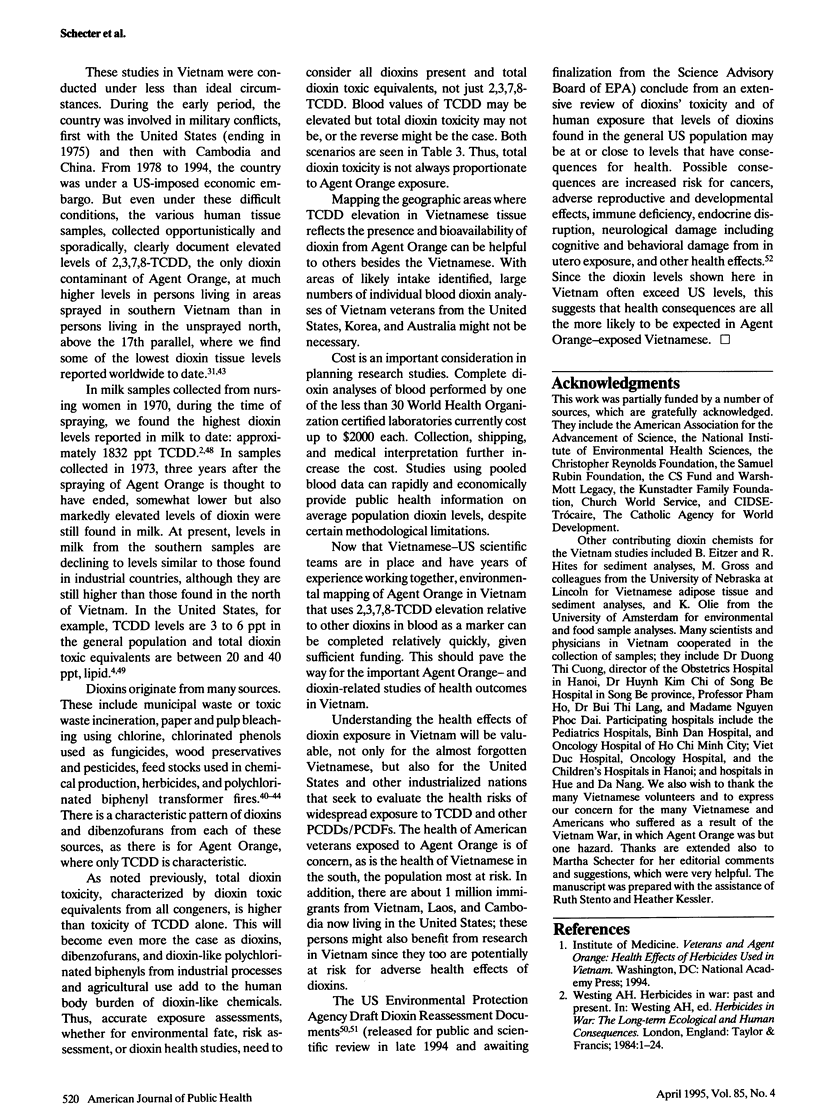

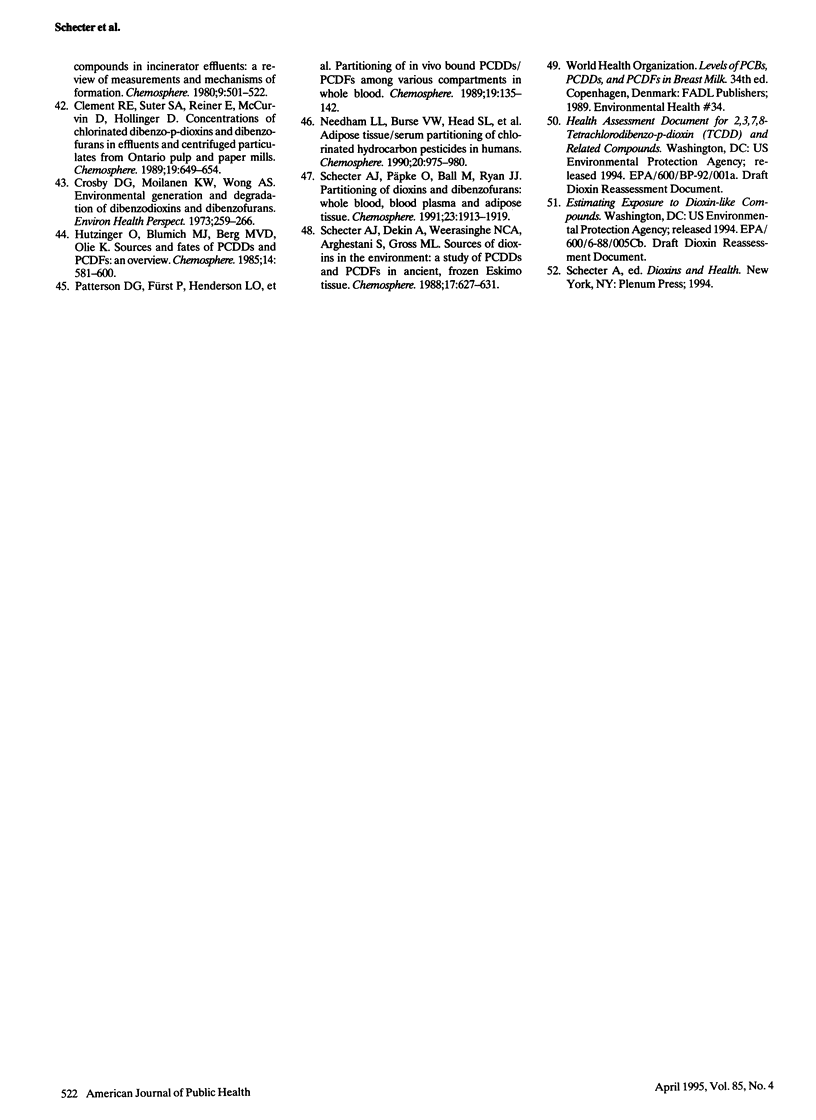
Selected References
These references are in PubMed. This may not be the complete list of references from this article.
- Baughman R., Meselson M. An analytical method for detecting TCDD (dioxin): levels of TCDD in samples from Vietnam. Environ Health Perspect. 1973 Sep;5:27–35. doi: 10.1289/ehp.730527. [DOI] [PMC free article] [PubMed] [Google Scholar]
- Constable J. D., Hatch M. C. Reproductive effects of herbicide exposure in Vietnam: recent studies by the Vietnamese and others. Teratog Carcinog Mutagen. 1985;5(4):231–250. doi: 10.1002/tcm.1770050404. [DOI] [PubMed] [Google Scholar]
- Crosby D. G., Moilanen K. W., Wong A. S. Environmental generation and degradation of dibenzodioxins and dibenzofurans. Environ Health Perspect. 1973 Sep;5:259–266. doi: 10.1289/ehp.7305259. [DOI] [PMC free article] [PubMed] [Google Scholar]
- Eadon G., Kaminsky L., Silkworth J., Aldous K., Hilker D., O'Keefe P., Smith R., Gierthy J., Hawley J., Kim N. Calculation of 2,3,7,8-TCDD equivalent concentrations of complex environmental contaminant mixtures. Environ Health Perspect. 1986 Dec;70:221–227. doi: 10.1289/ehp.8670221. [DOI] [PMC free article] [PubMed] [Google Scholar]
- Eriksson M., Hardell L., Adami H. O. Exposure to dioxins as a risk factor for soft tissue sarcoma: a population-based case-control study. J Natl Cancer Inst. 1990 Mar 21;82(6):486–490. doi: 10.1093/jnci/82.6.486. [DOI] [PubMed] [Google Scholar]
- Fingerhut M. A., Halperin W. E., Marlow D. A., Piacitelli L. A., Honchar P. A., Sweeney M. H., Greife A. L., Dill P. A., Steenland K., Suruda A. J. Cancer mortality in workers exposed to 2,3,7,8-tetrachlorodibenzo-p-dioxin. N Engl J Med. 1991 Jan 24;324(4):212–218. doi: 10.1056/NEJM199101243240402. [DOI] [PubMed] [Google Scholar]
- Greenwald P., Kovasznay B., Collins D. N., Therriault G. Sarcomas of soft tissues after Vietnam service. J Natl Cancer Inst. 1984 Nov;73(5):1107–1109. [PubMed] [Google Scholar]
- Hoar S. K., Blair A., Holmes F. F., Boysen C. D., Robel R. J., Hoover R., Fraumeni J. F., Jr Agricultural herbicide use and risk of lymphoma and soft-tissue sarcoma. JAMA. 1986 Sep 5;256(9):1141–1147. [PubMed] [Google Scholar]
- Manz A., Berger J., Dwyer J. H., Flesch-Janys D., Nagel S., Waltsgott H. Cancer mortality among workers in chemical plant contaminated with dioxin. Lancet. 1991 Oct 19;338(8773):959–964. doi: 10.1016/0140-6736(91)91835-i. [DOI] [PubMed] [Google Scholar]
- Räisänen S., Hiltunen R., Arstila A. U., Sipiläinen T. Determination of 2,3,7,8-tetrachlorodibenzo-p-dioxin in goat milk and tissues by glass capillary gas chromatography and medium resolution mass fragmentography. J Chromatogr. 1981 Apr 17;208(2):323–330. doi: 10.1016/s0021-9673(00)81944-5. [DOI] [PubMed] [Google Scholar]
- Thiess A. M., Frentzel-Beyme R., Link R. Mortality study of persons exposed to dioxin in a trichlorophenol-process accident that occurred in the BASF AG on November 17, 1953. Am J Ind Med. 1982;3(2):179–189. doi: 10.1002/ajim.4700030209. [DOI] [PubMed] [Google Scholar]
- Zahm S. H., Weisenburger D. D., Babbitt P. A., Saal R. C., Vaught J. B., Cantor K. P., Blair A. A case-control study of non-Hodgkin's lymphoma and the herbicide 2,4-dichlorophenoxyacetic acid (2,4-D) in eastern Nebraska. Epidemiology. 1990 Sep;1(5):349–356. doi: 10.1097/00001648-199009000-00004. [DOI] [PubMed] [Google Scholar]
- Zober A., Messerer P., Huber P. Thirty-four-year mortality follow-up of BASF employees exposed to 2,3,7,8-TCDD after the 1953 accident. Int Arch Occup Environ Health. 1990;62(2):139–157. doi: 10.1007/BF00383591. [DOI] [PubMed] [Google Scholar]


